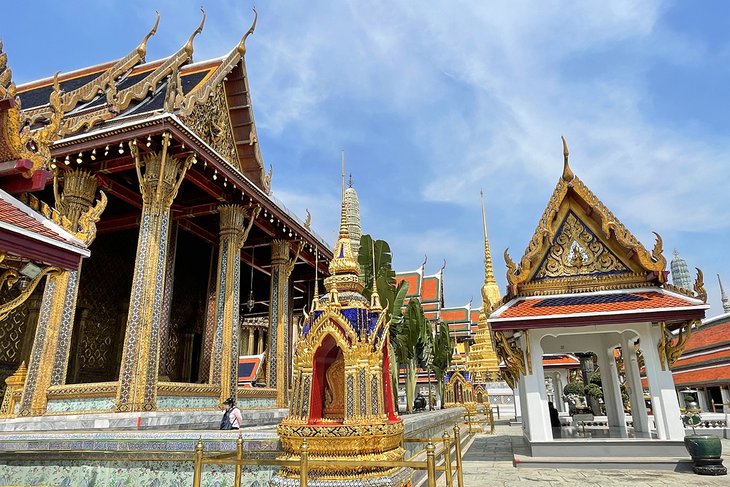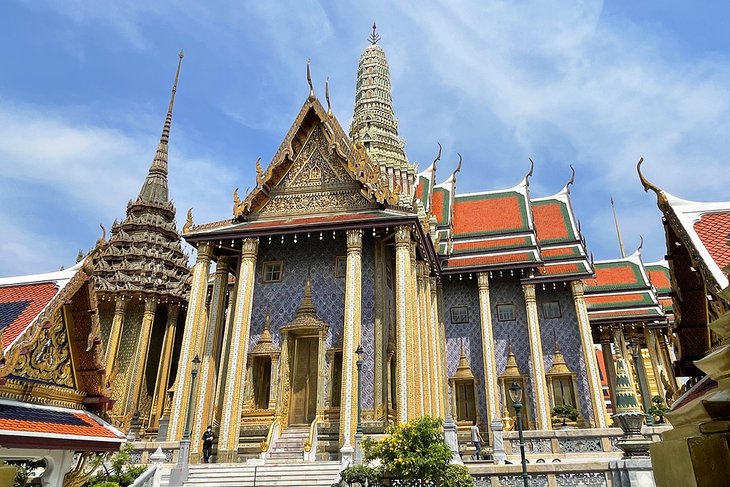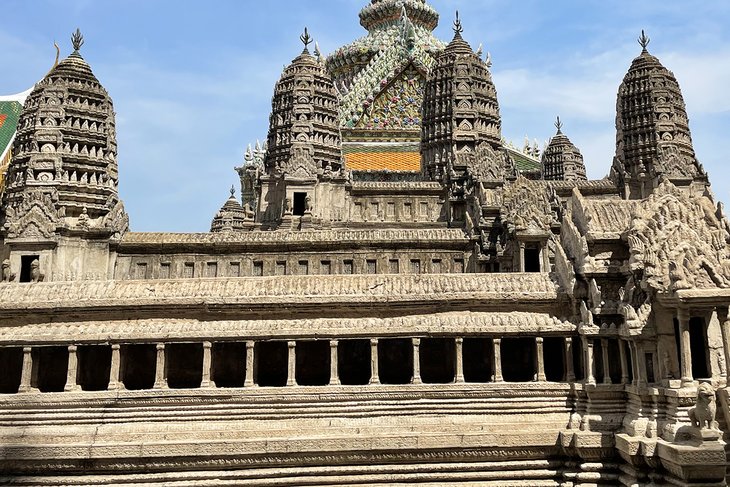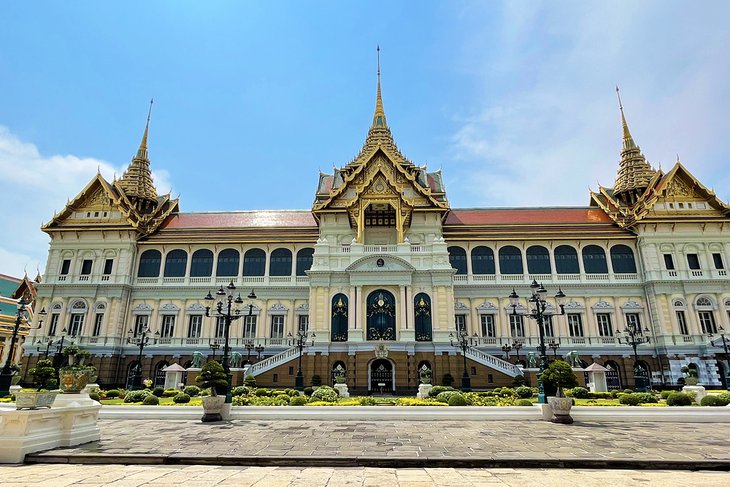Jade Buddha - or the Emerald Buddha.

During the centuries since it was first built, the palace grounds have been well maintained with particular care being taken to preserve and restore the palace's extensive murals. Though the entrance fee (500 baht) is a bit steeper than most tourist attractions in this country, it's worth the splurge to experience a piece of Thailand's royal history firsthand.
Hours: 8:30am-3:30pm daily
Admission: 500 baht; additional 100 baht for audio guides (available in English, French, German, Spanish, Mandarin, Russian, and Japanese)
Location: Na Phra Lan Road, Phra Borom Maha Ratchawang, Phra Nakhon
Official site: http://www.palaces.thai.net/
Things to See at the Grand Palace
Wat Phra Kaeo/Temple of the Emerald Buddha

Wat Phra Kaeo/Temple of the Emerald Buddha
In a stark contrast to the spiritual nature of the temple and to traditionally elegant Thai architecture, this holy site is guarded by two imposing demon figures. These statues, gifts from Chinese merchants, stand sentinel at the gate to the gorgeous temple. Those brave enough to pass by the demons are treated to a cycle of murals recounting the epic of "Ramakien" and commentary by King Rama V inscribed on marble plaques nearby. The gold-tiled chedi, known as Phra Si Ratana, contains a relic that (according to tradition) is a bone or hair of the enlightened Buddha.
Inside the bot, the small but exquisite statue of the Buddha, less than a meter high, rests on a tall plinth beneath a nine-tiered canopy. According to tradition the nephrite figure was carved in Pataliputra in India, though other sources claim it to be from Burma and the work of an unknown artist. It first came to light in 1434 in Chiang Rai, northern Thailand, having arrived there by way of Ceylon (now Sri Lanka) and Cambodia. At the time of its discovery, the statue was encased in plaster. While in the process of being transported, the casing was damaged and split open, revealing the nephrite figure within. The Buddha traveled a long way to end up in Bangkok in 1778, where it has been kept ever since. Three times a year, the king changes the Buddha's robes during a special ceremony to mark the beginning of a new season.
Phra Mondhop

Phra Mondhop
Behind Phra Sri Ratana is Phra Mondhop, a building decorated liberally with tiny glass mosaics. This building holds the "Tripitaka" (Triple Basket) - the sacred scriptures. The scriptures sit on a black lacquered bookcase inlaid with mother-of-pearl, and the floor of the mondhop is made of pure silver.
Phra Viharn Yot
Phra Viharn Yot has the distinction of housing the most ancient of all the treasures in the sacred precinct: a stone that served as a throne for Ramkhamhaeng, the 13th c founder of Thailand. King Mongkut (Rama IV) uncovered the throne, during his years of wandering as a monk, and it was he who brought it to Bangkok.
Prasat Phra Debidorn
The Prasat Phra Debidorn building is also called the Pantheon. The interior contains life-size statues of the first eight kings of the Chakri dynasty (the present monarch, King Bhumibol, is the ninth member of this dynastic line). But good luck catching a glimpse of the kings - the interior is only open to the general public one day a year, Chakri Day (April 6).
Angkor Wat

Angkor Wat
If you can't make it to the real Angkor Wat, you can at least see a version of it at the Grand Palace. Admittedly, it's not as impressive as the real thing, but the stone model does offer an interesting history lesson and a glimpse at the landmark as it was being planned. The model dates from the reign of Rama IV, when what is now Cambodia was a vassal state of Siam.
Boromabiman Hall
Boromabiman Hall is the official name for the building that overlooks the lawns where the king's annual garden party used to be held. Frescos inside depict the four Indian gods (Indra, Yahuma, Varuna and Agni) as guardians of the universe. Inscribed on plaques beneath are the ten royal virtues: liberality, propriety, readiness to make sacrifices, clemency, modesty, conscientiousness, freedom from anger, freedom from suspicion, patience and right dealing.
Ever since the time of Rama VI, all the Crown Princes, including King Bhumibol, have grown up here. Nowadays the building is only used occasionally, usually to accommodate visiting heads of state or high-ranking Buddhist dignitaries.
The Great Chakri Palace

The Great Chakri Palace
Though it is no longer the royal residence (the present king lives at the Chitralada Residence), the Great Chakri Palace is still something special to behold. It was originally designed by an English architect in Italian Renaissance style, but King Rama V ordered that it be embellished with typically Siamese stepped roofs and mondhops. Still, the design is clearly out of place when compared with the other buildings, though it harmonizes with its surroundings when seen by air. As well as being notable for the richness of their interiors, all the rooms in the palace are treasure troves with valuable paintings and portraits of every Thai king.
Amarindra Vinichai
This is the "High Residence" - essentially a throne room where King Rama I once received homage. The hall is still used today, often in ceremonies involving heads of state or for the anniversary celebration of the present king's coronation. You can see a peristyle in front of the building, which is where royal proclamations used to be read. Notice the red and gold posts, where elephants were once tethered.
Dusit Maha Prasat
The single large inner hall of this building, which is open to visitors, was originally Rama I's Audience Chamber. Here the king received his guests, seated, not on the large throne seen today, but higher up on a niche-like throne set in the south wing wall. The murals were painted in a later period, when the chamber became used for deceased monarchs lying-in-state. The richly ornamented couch and a number of other individual pieces of furniture do, however, date from Rama I's time.
Amphorn Phimok Prasat
When leaving the Dusit Maha Prasat, the delicate wooden pavilion ahead is the Amphorn Phimok Prasat, used by Rama I as a robing chamber. Having "progressed" here in his litter, the king would change before entering the audience room. Drapes interlaced with gold thread would be drawn while the king donned his ceremonial robes.

No comments:
Post a Comment